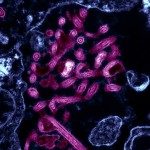Lien vers Pubmed [PMID] – 39343560
Lien DOI – 10.7883/yoken.JJID.2023.255
Jpn J Infect Dis 2025 Jan; 78(1): 8-18
We estimated the seroprevalence of anti-severe acute respiratory syndrome coronavirus 2 (anti-SARS-CoV-2) immunoglobulin G (IgG) in different island groups in Okinawa. A cross-sectional serosurvey was conducted over three periods between July 2020 and February 2021. A total of 2,683 serum samples were collected from six referral medical centers, each covering a separate region in Okinawa. In the main island, the seroprevalence was 0.0% (0/392; 95% confidence interval (CI), 0.0- 0.9%), 0.6% (8/1,448, 0.2-1.1%), and 1.4% (8/582, 0.6-2.7%) during the 1st, 2nd, and 3rd serosurvey, respectively. In remote islands, the seroprevalence was 0.0% (0/144; 95% CI, 0.0-2.5%) and 1.6% (2/123, 0.2-5.8%) during the 2nd and 3rd survey, respectively. The case detection ratio was 2.7 (95% CI, 1.3-5.3) in the main island and 2.8 (0.7-11.1) in remote islands during the 3rd survey. The case detection ratio was the highest in individuals aged 20-29 years (8.3; 95% CI, 3.3-21.4) in the main island and in those aged 50-59 years (14.1; 2.1-92.7) in remote islands, suggesting underreporting of clinical cases by the surveillance system in these subgroups. A serosurvey conducted during an emerging infectious disease epidemic can be useful for validating the reliability of the surveillance system by providing case detection ratio.

